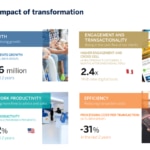BBVA’s Digital Transformation delivering the results
Last week during the 2019 first quarter results presentation, BBVA CEO Onur Genç outlined some of the continued progress the bank has been making in its digital transformation.

The BBVA executive also talked about the clear link the business was seeing between the transformation programme and the bank’s performance.
He stated that: “We continue to move forward in our transformation, with a clear impact on growth of our customer base, productivity, efficiency and user experience.”
Genç reiterated that: “Digital sales accounted for 57 percent of the total for the quarter. We maintain our goal of surpassing the 50-percent threshold of customers banking with us through their smartphones by year-end.”
There are dozens more that the bank actively tracks, in real time, to ensure it is delivering on its transformation plan.
For example, how digital is driving growth across the business - with the bank reporting it has seen an increase in the number of active digital clients of 4.6 million, +8% in the last two years alone. “We believe, it is now the right time to boost activity and grow our customer base further leveraging also digital”, he said.
Part of the reason for this growth is the simplicity BBVA has injected into its digital platforms, which was one of the reasons the bank has been nominated by Forrester for the last two years in a row as having the best mobile banking app in the world.
But this ability to deliver products and services to the digital platforms starts with getting them into a self-serve standard, which BBVA has worked hard on accelerating, moving to in excess of 95 percent availability during the first quarter of 2019 for consumers and 83 percent taken across the group.
This translates into better service for customers and better efficiency and performance for the bank - for example in the results presentation, analysts were shown how in Peru the number of clients with more than one product had multiplied 2.4 times three months after they joined the bank, thanks to BBVA’s digital engagement processes.
Equally, for our colleagues, there was a direct correlation seen between increasing use of self-serve digital channels for customers, and the subsequent reduced time they spent helping people with more mundane tasks in branch. Instead, as was seen in statistics from the U.S., colleagues were able to spend more time offering advice on more significant matters, resulting in the products sold per branch per month in the United States have increased by 42% since 1Q17.
The BBVA CEO also outlined the impact seen in the operating costs for the bank, with the processing cost per transaction across the BBVA Group falling by 31 percent over the past two-years, as a result of the channel mix of transactions as well as the measures to increase the efficiency of our platforms.

The impact of transformation
And as Genç reiterated, another way this is seen is the growth in digital and mobile customers which is leading to an impressive growth trend in digital sales.
As of the end of Q1 2019, digital customers at the bank had passed the 53 percent mark, with a YoY growth rate of 17 percent to 28.4 million.
In mobile, the growth rate YoY was higher at 25 percent, with the penetration rate at 45 percent and looking set to pass the 50 percent tipping point this year.
All of which translated into digital sales figure of now 57 percent of all product and service transactions across the group are done through digital channels, a growth of 9 percent from the end of March 2018 a year earlier.